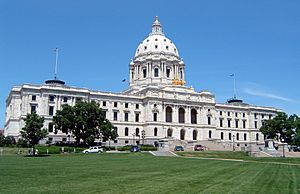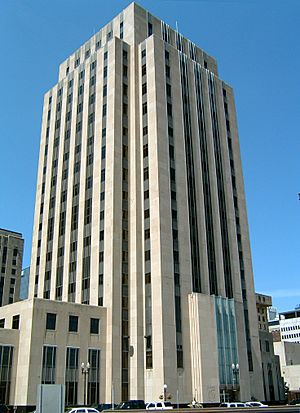Government and politics in Saint Paul, Minnesota facts for kids
Saint Paul, Minnesota is the capital city of Minnesota. It's also the biggest city and the main government center for Ramsey County. Saint Paul uses a "strong mayor-council" system to run its government. This means a mayor is elected by everyone in the city, and seven city council members are elected from different parts of the city called "wards."
Contents
How Saint Paul's Government Works
Saint Paul uses a type of government called the "strong mayor-council" system. Think of the mayor as the city's boss, in charge of running things day-to-day. The city council, which has seven members, is like the city's law-making group.
The mayor is chosen by all the voters in Saint Paul. The city council members are chosen by voters in seven different areas, or "wards," which have about the same number of people. Both the mayor and council members serve for four years.
The mayor's jobs include:
- Creating the city's yearly budget.
- Choosing people to lead different city departments.
- Signing new laws (called "ordinances") passed by the city council, or saying "no" to them (this is called a "veto").
The city council's jobs include:
- Approving the city's budget, usually based on what the mayor suggests.
- Approving the people the mayor wants to appoint to lead departments.
- Making all of the city's laws.
- They can even overrule the mayor's "no" (veto) if enough council members agree.
Besides the mayor and city council, Saint Paul also has a special neighborhood system. Since 1975, the city has been divided into 17 "City Districts." Each district has its own "District Council." These councils get money from the city but run themselves. Many of them have a lot of say in how land is used in their area.
The City Council Members
As of the 2015 election, the Saint Paul City Council members were:
- 1st Ward: Dai Thao (DFL)
- 2nd Ward: Rebecca Noecker (DFL)
- 3rd Ward: Chris Tolbert (DFL)
- 4th Ward: Russ Stark (DFL)
- 5th Ward: Amy Brendmoen (DFL)
- 6th Ward: Dan Bostrom (DFL)
- 7th Ward: Jane Prince (DFL)
Saint Paul and the State Government

Saint Paul is very important to the state of Minnesota because it is the state capital. This means it's where the main state government buildings are located.
Here are some important state buildings in Saint Paul:
- The Minnesota State Capitol building, which was designed by a famous architect named Cass Gilbert who lived in Saint Paul.
- The Minnesota Supreme Court, which is the highest court in the state, meets in the State Capitol.
- The Minnesota Judicial Center, another important court building.
- Office buildings for the Minnesota House of Representatives and Senate, where state lawmakers work.
- The Minnesota Governor's Residence on Summit Avenue, which is used for some state events.
The main office for the Minnesota Democratic-Farmer-Labor Party (DFL), which is connected to the national Democratic Party, is also in Saint Paul.
Saint Paul is also the main government center, or "county seat," for Ramsey County.
The city is represented by several lawmakers in the state government. It has four Minnesota Senate districts (64, 65, 66, and 67) and eight Minnesota House of Representatives districts (64A, 64B, 65A, 65B, 66A, 66B, 67A, and 67B).
Saint Paul and the Federal Government
Saint Paul is part of Minnesota's 4th congressional district. This district usually votes for the Democratic Party. The district is currently represented by Betty McCollum, a Democrat.
A former mayor of Saint Paul, Norm Coleman, later became a U.S. Senator.
In 2008, Saint Paul's Xcel Energy Center was chosen to host the 2008 Republican National Convention, which is a big meeting where the Republican Party chooses its candidate for president.


